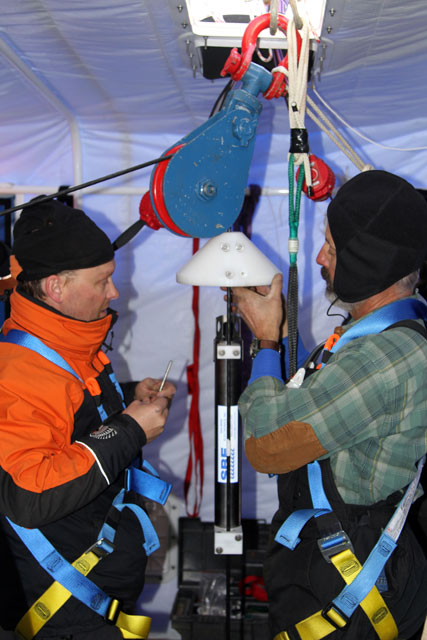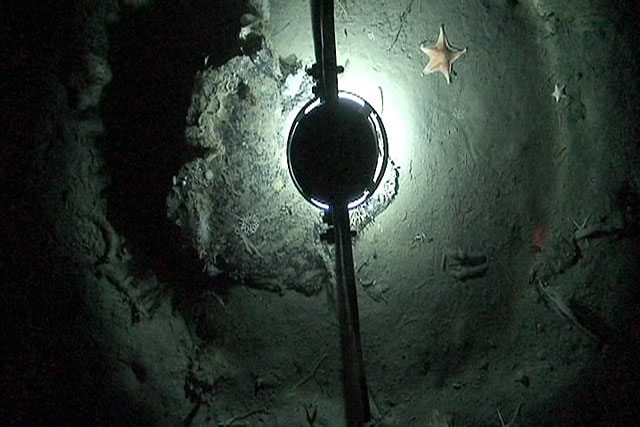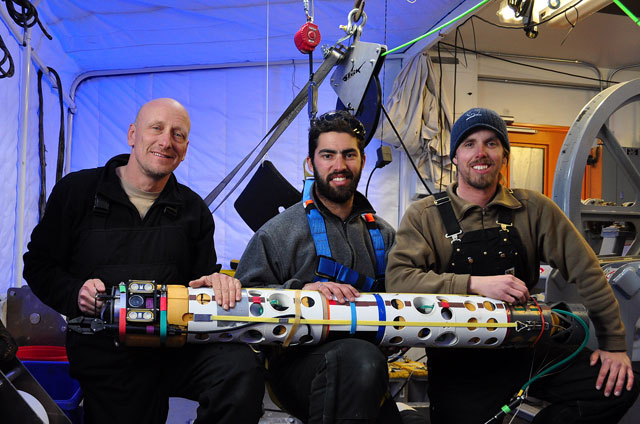Page 2/2 - Posted July 29, 2011
Scientist would like to see international ANDRILL program around AntarcticaThat required hauling people and equipment nearly 150 kilometers from the U.S. Antarctic Program’s Using ANDRILL’s hotwater drill system, the scientists and support personnel punched several holes in the ice shelf. Oceanographers from Woods Hole Oceanographic Institution 
Photo Credit: Frank Rack, ANDRILL Science Management Office, UNL
Oceanographers from the National Institute of Water and Atmospheric Research in New Zealand and Woods Hole Oceanographic Institution in the United States prepare an instrument for deployment through the ice hole.
“Both of those deployments went really well,” said Rack, adding that the current meter moorings had brought back the first real-time velocity and water property data throughout the water column under the Ross Ice Shelf. “We really tried to think about what was the ancillary science that could be done as part of this survey activity,” he added. Through another hole, the scientists dropped a video camera that allowed them to examine the ice shelf cavity and seafloor. Starfish, sponges and other benthic, or bottom-dwelling marine critters, were spotted. “That turned out to be real interesting,” Rack said. The Coulman High site visit also offered an opportunity to test the capabilities of a underwater robot called SCINI (Submersible Capable of under Ice Navigation and Imaging) Shaped like a torpedo and designed to fit through holes made in sea ice that is only a few meters thick, SCINI sports a manipulator arm and camera. The remotely operated vehicle (ROV) made a series of dives over 10 days, reaching a maximum depth of about 300 meters, and made a significant biological discovery that is currently being documented. “It roamed all underneath the ice shelf,” Rack said. “It bodes well for trying to increase its depth capability to the seafloor and also give it more missions than just seeing and looking.” SCINI could play a pivotal role in the final drilling operation, which will likely involve coring into one site on the seafloor for as long as technically feasible. SCINI could observe the bending of the riser and help determine when to terminate drilling. The drillers would then start a second hole, drilling as fast as possible to reach a depth that matches up well with where the first hole left off before returning to coring. Rack said the ANDRILL team would submit a proposal to drill two sites at Coulman High within a couple of years. The New Zealand Antarctic science program is already on board, and he expects other nations will also join the effort. South Korea, Brazil, the United Kingdom and other European countries have expressed interest the Coulman High Project, according to Rack. The two previous field campaigns involved Germany, Italy, New Zealand and the United States, with about two-thirds of the $30 million coming from the National Science Foundation Eventually, Rack said, he would like to see a sustained international ANDRILL effort, akin to the International Trans-Antarctic Scientific Expedition (ITASE) “The preparation for this future effort would first involve conducting surveys to identify prospective sites where scientific drilling could take place,” Rack said. “What we’re trying to do is coordinate site-specific activities, while also expressing a circum-Antarctic, long-term sciences strategy.” NSF-funded research in this story: Frank Rack, University of Nebraska-Lincoln, Award No. 0839108 |



For USAP Participants |
For The Public |
For Researchers and EducatorsContact UsNational Science FoundationOffice of Polar Programs Geosciences Directorate 2415 Eisenhower Avenue, Suite W7100 Alexandria, VA 22314 Sign up for the NSF Office of Polar Programs newsletter and events. Feedback Form |



